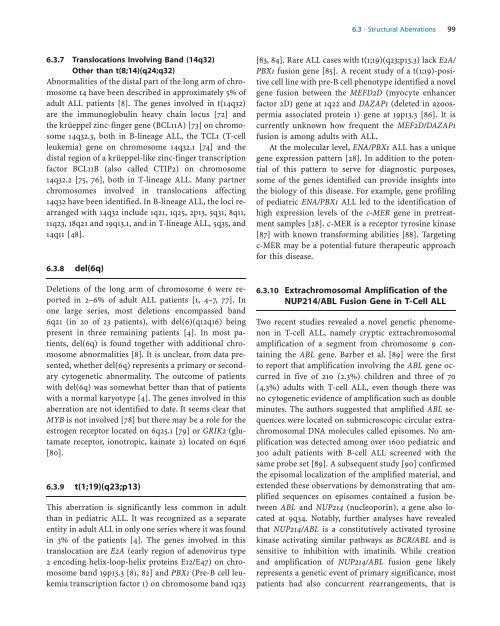Acute Leukemias - Republican Scientific Medical Library
Acute Leukemias - Republican Scientific Medical Library
Acute Leukemias - Republican Scientific Medical Library
You also want an ePaper? Increase the reach of your titles
YUMPU automatically turns print PDFs into web optimized ePapers that Google loves.
a 6.3 · Structural Aberrations 99<br />
6.3.7 Translocations Involving Band (14q32)<br />
Other than t(8;14)(q24;q32)<br />
Abnormalities of the distal part of the long arm of chromosome<br />
14 have been described in approximately 5% of<br />
adult ALL patients [8]. The genes involved in t(14q32)<br />
are the immunoglobulin heavy chain locus [72] and<br />
the krüeppel zinc-finger gene (BCL11A) [73] on chromosome<br />
14q32.3, both in B-lineage ALL, the TCL1 (T-cell<br />
leukemia) gene on chromosome 14q32.1 [74] and the<br />
distal region of a krüeppel-like zinc-finger transcription<br />
factor BCL11B (also called CTIP2) on chromosome<br />
14q32.2 [75, 76], both in T-lineage ALL. Many partner<br />
chromosomes involved in translocations affecting<br />
14q32 have been identified. In B-lineage ALL, the loci rearranged<br />
with 14q32 include 1q21, 1q25, 2p13, 5q31, 8q11,<br />
11q23, 18q21 and 19q13.1, and in T-lineage ALL, 5q35, and<br />
14q11 [48].<br />
6.3.8 del(6q)<br />
Deletions of the long arm of chromosome 6 were reported<br />
in 2–6% of adult ALL patients [1, 4–7, 77]. In<br />
one large series, most deletions encompassed band<br />
6q21 (in 20 of 23 patients), with del(6)(q12q16) being<br />
present in three remaining patients [4]. In most patients,<br />
del(6q) is found together with additional chromosome<br />
abnormalities [8]. It is unclear, from data presented,<br />
whether del(6q) represents a primary or secondary<br />
cytogenetic abnormality. The outcome of patients<br />
with del(6q) was somewhat better than that of patients<br />
with a normal karyotype [4]. The genes involved in this<br />
aberration are not identified to date. It seems clear that<br />
MYB is not involved [78] but there may be a role for the<br />
estrogen receptor located on 6q25.1 [79] or GRIK2 (glutamate<br />
receptor, ionotropic, kainate 2) located on 6q16<br />
[80].<br />
6.3.9 t(1;19)(q23;p13)<br />
This aberration is significantly less common in adult<br />
than in pediatric ALL. It was recognized as a separate<br />
entity in adult ALL in only one series where it was found<br />
in 3% of the patients [4]. The genes involved in this<br />
translocation are E2A (early region of adenovirus type<br />
2 encoding helix-loop-helix proteins E12/E47) on chromosome<br />
band 19p13.3 [81, 82] and PBX1 (Pre-B cell leukemia<br />
transcription factor 1) on chromosome band 1q23<br />
[83, 84]. Rare ALL cases with t(1;19)(q23;p13.3) lack E2A/<br />
PBX1 fusion gene [85]. A recent study of a t(1;19)-positive<br />
cell line with pre-B cell phenotype identified a novel<br />
gene fusion between the MEFD2D (myocyte enhancer<br />
factor 2D) gene at 1q22 and DAZAP1 (deleted in azoospermia<br />
associated protein 1) gene at 19p13.3 [86]. It is<br />
currently unknown how frequent the MEF2D/DAZAP1<br />
fusion is among adults with ALL.<br />
At the molecular level, ENA/PBX1 ALL has a unique<br />
gene expression pattern [28]. In addition to the potential<br />
of this pattern to serve for diagnostic purposes,<br />
some of the genes identified can provide insights into<br />
the biology of this disease. For example, gene profiling<br />
of pediatric ENA/PBX1 ALL led to the identification of<br />
high expression levels of the c-MER gene in pretreatment<br />
samples [28]. c-MER is a receptor tyrosine kinase<br />
[87] with known transforming abilities [88]. Targeting<br />
c-MER may be a potential future therapeutic approach<br />
for this disease.<br />
6.3.10 Extrachromosomal Amplification of the<br />
NUP214/ABL Fusion Gene in T-Cell ALL<br />
Two recent studies revealed a novel genetic phenomenon<br />
in T-cell ALL, namely cryptic extrachromosomal<br />
amplification of a segment from chromosome 9 containing<br />
the ABL gene. Barber et al. [89] were the first<br />
to report that amplification involving the ABL gene occurred<br />
in five of 210 (2.3%) children and three of 70<br />
(4.3%) adults with T-cell ALL, even though there was<br />
no cytogenetic evidence of amplification such as double<br />
minutes. The authors suggested that amplified ABL sequences<br />
were located on submicroscopic circular extrachromosomal<br />
DNA molecules called episomes. No amplification<br />
was detected among over 1600 pediatric and<br />
300 adult patients with B-cell ALL screened with the<br />
same probe set [89]. A subsequent study [90] confirmed<br />
the episomal localization of the amplified material, and<br />
extended these observations by demonstrating that amplified<br />
sequences on episomes contained a fusion between<br />
ABL and NUP214 (nucleoporin), a gene also located<br />
at 9q34. Notably, further analyses have revealed<br />
that NUP214/ABL is a constitutively activated tyrosine<br />
kinase activating similar pathways as BCR/ABL and is<br />
sensitive to inhibition with imatinib. While creation<br />
and amplification of NUP214/ABL fusion gene likely<br />
represents a genetic event of primary significance, most<br />
patients had also concurrent rearrangements, that is
















